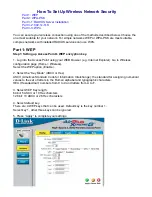
Authentication and User Management
14.2 Supported Authentication Methods
SCALANCE W1750D UI
204
Configuration Manual, 02/2018, C79000-G8976-C451-02
L2 authentication fall-through—Allows you to enable the l2-authentication-fallthrough mode.
When this option is enabled, the 802.1X authentication is allowed even if the MAC
authentication fails. If this option is disabled, 802.1X authentication is not allowed. The l2-
authentication-fallthrough mode is disabled by default.
For more information on configuring an AP to use MAC as well as 802.1X authentication,
see Configuring MAC Authentication with 802.1X Authentication.
Captive Portal Authentication
Captive portal authentication is used for authenticating guest users.
For more information on captive portal authentication, see Captive Portal for Guest Access.
MAC Authentication with Captive Portal Authentication
You can enforce MAC authentication for captive portal clients.
For more information on configuring an AP to use MAC authentication with captive portal
authentication, see Configuring MAC Authentication with Captive Portal Authentication.
802.1X Authentication with Captive Portal Role
his authentication mechanism allows you to configure different captive portal settings for
clients on
the same SSID. For example, you can configure an 802.1X SSID and create a role for
captive portal access, so that some of the clients using the SSID derive the captive portal
role. You can configure rules to indicate access to external or internal captive portal, or none.
For more information on configuring captive portal roles for an SSID with 802.1X
authentication, see Configuring Captive Portal Roles for an SSID.
WISPr Authentication
Wireless Internet Service Provider roaming (WISPr) authentication allows the smart clients to
authenticate on the network when they roam between wireless Internet service providers,
even if the wireless hotspot uses an Internet Service Provider (ISP) with whom the client
may not have an account.
If a hotspot is configured to use WISPr authentication in a specific ISP and a client attempts
to access the Internet at that hotspot, the WISPr AAA server configured for the ISP
authenticates the client directly and allows the client to access the network. If the client only
has an account with a
partner
ISP,
the WISPr AAA server forwards the client’s credentials to the partner ISP’s WISPr AAA
server for authentication. When the client is authenticated on the partner ISP, it is also
authenticated on the hotspot’s own ISP as per their service agreements. The AP assigns the
default WISPr user role to the client when the client's ISP sends an authentication message
to the AP. For more information on WISPr authentication, see Configuring WISPr
Authentication.
















































